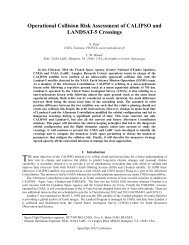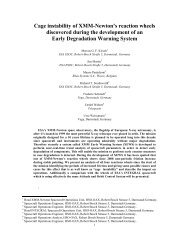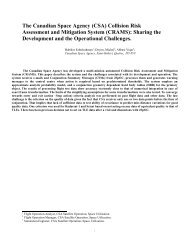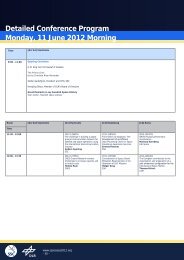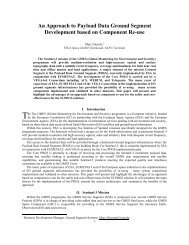Satellite Control System Based on Operation ... - SpaceOps 2012
Satellite Control System Based on Operation ... - SpaceOps 2012
Satellite Control System Based on Operation ... - SpaceOps 2012
Create successful ePaper yourself
Turn your PDF publications into a flip-book with our unique Google optimized e-Paper software.
<str<strong>on</strong>g>Satellite</str<strong>on</strong>g> <str<strong>on</strong>g>C<strong>on</strong>trol</str<strong>on</strong>g> <str<strong>on</strong>g>System</str<strong>on</strong>g> <str<strong>on</strong>g>Based</str<strong>on</strong>g> <strong>on</strong> Operati<strong>on</strong> Predicti<strong>on</strong><br />
WANG Baohua1<br />
State Key Laboratory of Astr<strong>on</strong>autic Dynamics,Xi’an <str<strong>on</strong>g>Satellite</str<strong>on</strong>g> <str<strong>on</strong>g>C<strong>on</strong>trol</str<strong>on</strong>g> Center,Xi’an,China,710073<br />
FANG D<strong>on</strong>g2 and Wang Xin3<br />
Xi’an <str<strong>on</strong>g>Satellite</str<strong>on</strong>g> <str<strong>on</strong>g>C<strong>on</strong>trol</str<strong>on</strong>g> Center,Xi’an,China,710073<br />
LI Jing4<br />
State Key Laboratory of Astr<strong>on</strong>autic Dynamics,Xi’an <str<strong>on</strong>g>Satellite</str<strong>on</strong>g> <str<strong>on</strong>g>C<strong>on</strong>trol</str<strong>on</strong>g> Center,Xi’an,China,710073<br />
In a satellite c<strong>on</strong>trol center, the real-time c<strong>on</strong>trol system is a key link for complex missi<strong>on</strong><br />
operati<strong>on</strong>s. However, in crucial operati<strong>on</strong>s, the existing methods to m<strong>on</strong>itor and judge the<br />
procedure are improper to the complex procedures; and it depends heavily <strong>on</strong> the professi<strong>on</strong>al<br />
engineers to m<strong>on</strong>itor and estimate the entire process. To deal with this problem, in this paper,<br />
we propose an operati<strong>on</strong>-predicti<strong>on</strong> c<strong>on</strong>cept, c<strong>on</strong>stitute a real-time c<strong>on</strong>trol system, and design a<br />
<str<strong>on</strong>g>Satellite</str<strong>on</strong>g> <str<strong>on</strong>g>C<strong>on</strong>trol</str<strong>on</strong>g> and M<strong>on</strong>itor Language (SCML) to describe the predicti<strong>on</strong>. This overall<br />
soluti<strong>on</strong> can correctly describe the behaviour of the spacecraft during whole c<strong>on</strong>trol procedure,<br />
and provide accurate and quick judgments for the critical operati<strong>on</strong>.<br />
I. Introducti<strong>on</strong><br />
Real-time judgment is an important part in the satellite-ground c<strong>on</strong>trol procedure. During the crucial operati<strong>on</strong> phases,<br />
the operator must m<strong>on</strong>itor and judge the state of satellite quickly and accurately. On <strong>on</strong>e hand, a false warning will<br />
interrupt current operati<strong>on</strong>, which will directly affect the following operati<strong>on</strong>s and disturb the whole plan. On the other<br />
hand, a neglected warning, as well as a delayed warning, will lead to missing the chance to rescue the satellite from<br />
malfuncti<strong>on</strong>, which may result in the failure of the missi<strong>on</strong>.<br />
The m<strong>on</strong>itor system is <strong>on</strong>e of main parts in the real-time c<strong>on</strong>trol system, as shown in Figure 1. The judgment from the<br />
m<strong>on</strong>itor system is the base for the following plans and operati<strong>on</strong>s. So that the main functi<strong>on</strong>s of real-time m<strong>on</strong>itor<br />
system are to estimate the behavior quickly and accurately, and to judge the procedure with a proper tolerance.<br />
1 Sr. engineer, State Key Laboratory of Astr<strong>on</strong>autic Dynamics, Xi’an <str<strong>on</strong>g>Satellite</str<strong>on</strong>g> <str<strong>on</strong>g>C<strong>on</strong>trol</str<strong>on</strong>g> Center, No.28 East Xianning<br />
Road, Xi’an City, Shaanxi Province, China,710043,Email:bhwang2000@163.com<br />
2 Project Manager, Xi’an <str<strong>on</strong>g>Satellite</str<strong>on</strong>g> <str<strong>on</strong>g>C<strong>on</strong>trol</str<strong>on</strong>g> Center, No.28 East Xianning Road, Xi’an City, Shaanxi Province,<br />
China,710043<br />
3 Sr. Engineer, Xi’an <str<strong>on</strong>g>Satellite</str<strong>on</strong>g> <str<strong>on</strong>g>C<strong>on</strong>trol</str<strong>on</strong>g> Center, No.28 East Xianning Road, Xi’an City, Shaanxi Province,<br />
China,710043<br />
4 Sr. engineer, State Key Laboratory of Astr<strong>on</strong>autic Dynamics, Xi’an <str<strong>on</strong>g>Satellite</str<strong>on</strong>g> <str<strong>on</strong>g>C<strong>on</strong>trol</str<strong>on</strong>g> Center, No.28 East Xianning<br />
Road, Xi’an City, Shaanxi Province, China,710043
Spacecraft<br />
Real-time<br />
<str<strong>on</strong>g>C<strong>on</strong>trol</str<strong>on</strong>g> Loop<br />
Command&<br />
<str<strong>on</strong>g>C<strong>on</strong>trol</str<strong>on</strong>g><br />
M<strong>on</strong>itor&<br />
Judgement<br />
Operati<strong>on</strong><br />
Team<br />
Decisi<strong>on</strong>&<br />
Plan<br />
Figure 1. Real Time <str<strong>on</strong>g>C<strong>on</strong>trol</str<strong>on</strong>g> Loop<br />
During crucial operati<strong>on</strong> phases, there are many complex events c<strong>on</strong>nected with each other, which would change the<br />
spacecraft’s work mode, data range, and behavior. However, the current methods of automatic m<strong>on</strong>itor can <strong>on</strong>ly carry<br />
out some simple judgment under stable states, and they are inappropriate to the dynamic operati<strong>on</strong> and changing<br />
telemetry. The operati<strong>on</strong> team members are still relied <strong>on</strong> heavily to m<strong>on</strong>itor and judge the satellite’s behavior. The<br />
soluti<strong>on</strong>s of real-time judgment are far behind the requirements.<br />
1. Analysis <strong>on</strong> Current Methods<br />
To m<strong>on</strong>itor the operati<strong>on</strong> procedure effectively, researchers from universities, enterprises and space agencies provided<br />
many methods and soluti<strong>on</strong>s for real-time operati<strong>on</strong> [1.2.3.4.5.6.7]. In general, there are three main methods applied in<br />
practice: manual judgment, command-based judgment, and expert system. However, these methods are still insufficient<br />
for the complex real-time operati<strong>on</strong> <strong>on</strong> satellites.<br />
1.1. Manual Judgment<br />
This is a very basic way to m<strong>on</strong>itor the c<strong>on</strong>trol procedure, depending <strong>on</strong> operati<strong>on</strong> team members. On the m<strong>on</strong>itor<br />
system, the latest telemetry data are refreshed, and the telemetry curves are shown to record the recent trends. But it is<br />
not shown whether the data are coherent to the c<strong>on</strong>trol procedure. The operators and experts are expected to judge and<br />
estimate the spacecraft’s activity according to their knowledge and experience [1.3].<br />
This method certainly costs too much manpower, as the crucial operati<strong>on</strong>s may last from m<strong>on</strong>ths in early orbit phase<br />
operati<strong>on</strong> to years in the l<strong>on</strong>g-run inter-planet explorati<strong>on</strong>.<br />
1.2. Command-based Judgment<br />
This is a way to judge the changing state of satellite after every command. In the command database, there are<br />
descripti<strong>on</strong>s which show the changes of certain telemetries corresp<strong>on</strong>ding to every command. That is a very basic<br />
functi<strong>on</strong> in satellite c<strong>on</strong>trol centers [2.4.5.7]. However, this approach has some limitati<strong>on</strong>s.<br />
1) It is difficult to judge some important commands. It is very comm<strong>on</strong> that a command is versatile with different<br />
parameters in it. As a result, it is hard to c<strong>on</strong>clude whether the command is executed.<br />
2) It is impossible to judge a l<strong>on</strong>g procedure. Usually a complex operati<strong>on</strong> could involve a list of combined command.<br />
But a simple additi<strong>on</strong> of every command’s effect would not be c<strong>on</strong>sidered as the real purpose of the c<strong>on</strong>trol.<br />
Although it is a basic ability, command-based judgment method is limited to the command level, and unfit for complex<br />
event.<br />
1.3. Expert <str<strong>on</strong>g>System</str<strong>on</strong>g><br />
Expert systems based <strong>on</strong> telemetry and rules are developed in c<strong>on</strong>trol centers [2.5.6], am<strong>on</strong>g which the rule-based<br />
expert system is a typical <strong>on</strong>e. It is good at routine procedures in which the satellite works in a stable mode.<br />
Nevertheless, there are still some crucial problems in the applicati<strong>on</strong> of expert system.<br />
1) For an expert system, it is difficult to fully understand the changing state of the satellite, because it is hard to give<br />
entirely reas<strong>on</strong>ing logic from hundreds of telemetries to a certain mode.<br />
2) The expert system may not understand the target and the course of the c<strong>on</strong>trol procedure, and could not distinguish<br />
an intended movement from an abnormity.
As a result, expert systems are often limited to calm phase with simple routine operati<strong>on</strong>s in a stable mode. It has many<br />
difficulties in supporting complex operati<strong>on</strong> in crucial phase.<br />
2. M<strong>on</strong>itor C<strong>on</strong>cept<br />
In the real-time c<strong>on</strong>trol system, there are 3 parts as judgment, decisi<strong>on</strong> and acti<strong>on</strong>, to c<strong>on</strong>stitute a c<strong>on</strong>trol loop.<br />
Depending <strong>on</strong> the judgment methods, we divide the c<strong>on</strong>trol loops into 2 types: percepti<strong>on</strong> loop and predicti<strong>on</strong> loop.<br />
2.1. Percepti<strong>on</strong> -based <str<strong>on</strong>g>C<strong>on</strong>trol</str<strong>on</strong>g> Loop<br />
The c<strong>on</strong>cept of Percepti<strong>on</strong>-based c<strong>on</strong>trol loop is shown in Figure2. In this loop, the c<strong>on</strong>troller could understand the<br />
object <strong>on</strong>ly by the observati<strong>on</strong> data. First, the data are logically reas<strong>on</strong>ed <strong>on</strong> the complex rules defined in a knowledge<br />
base, so that the satellite’s work mode is ascertained. Then all relative telemetry data are compared to the standard range<br />
in this work mode, and performance are evaluated. The expert system based <strong>on</strong> rules is in fact a typical<br />
percepti<strong>on</strong>-based c<strong>on</strong>trol mode.<br />
<str<strong>on</strong>g>C<strong>on</strong>trol</str<strong>on</strong>g>led<br />
Object<br />
Percepti<strong>on</strong>-based<br />
M<strong>on</strong>itor<br />
Acti<strong>on</strong> &<br />
Command<br />
Percepti<strong>on</strong><br />
Judgement<br />
Knowledge &<br />
Rules Base<br />
Boundary<br />
Decisi<strong>on</strong> &<br />
Planning<br />
Figure 2. Percepti<strong>on</strong>-based c<strong>on</strong>trol loop<br />
To understand the satellite’s working mode, it is essential that the knowledge rules are completely described, and the<br />
logical algorithms are computable. However, as the satellite has thousands of telemetry parameters which are closely<br />
related to each other, the vast parameters cause uncountable reas<strong>on</strong>ing logic rules from data to modes. Meanwhile,<br />
there may be abnormal data which will disturb the reas<strong>on</strong>ing process, and more logic models should be established to<br />
diminish the interference. Particularly, the satellite is affected by self-instructi<strong>on</strong> and ground-command, so that it is hard<br />
to understand the satellite’s movement and goal just from the current data.<br />
Therefore, percepti<strong>on</strong>-based c<strong>on</strong>trol loop is c<strong>on</strong>fined to the steady states and routine operati<strong>on</strong>s, and it may not be<br />
suitable in the crucial missi<strong>on</strong> operati<strong>on</strong>s with changing modes and active commands.<br />
2.2. Predicti<strong>on</strong>-based <str<strong>on</strong>g>C<strong>on</strong>trol</str<strong>on</strong>g> Loop<br />
In secti<strong>on</strong> 2.1 we introduce the “manual judgment” method, which is in fact a predicti<strong>on</strong> c<strong>on</strong>trol loop. How does the<br />
operati<strong>on</strong> team deal with the "percepti<strong>on</strong>" problems?<br />
As the operati<strong>on</strong> team members have planed operati<strong>on</strong>al events, they are very clear about every event’s objective and<br />
process; and the experts from every sub-system are aware of the performance of the character parameters. Observing<br />
the real-time data and their paces, comparing them with the predicted patterns in mind, judging with a tolerance, the<br />
operati<strong>on</strong> team comes to the c<strong>on</strong>clusi<strong>on</strong> whether the event c<strong>on</strong>trol procedure is correct. Figure 3 dem<strong>on</strong>strates the<br />
process. The judgment would c<strong>on</strong>tinue until the end of an event.<br />
<str<strong>on</strong>g>C<strong>on</strong>trol</str<strong>on</strong>g>led<br />
Object<br />
Predicti<strong>on</strong>-based<br />
M<strong>on</strong>itor<br />
Acti<strong>on</strong> &<br />
Command<br />
Predicted<br />
Model<br />
Judgement<br />
Decisi<strong>on</strong> &<br />
Planning<br />
Figure 3. Predicti<strong>on</strong>-based c<strong>on</strong>trol loop
From above descripti<strong>on</strong>, we can see that the operators would not mix the data together to “guess” what the satellite is<br />
doing now and where it is going. According to the c<strong>on</strong>trol events list, the operators know what the satellite should do<br />
and what the procedure should be like. This predicti<strong>on</strong> mode is more reas<strong>on</strong>able than the percepti<strong>on</strong> loop. So that with<br />
the predicti<strong>on</strong> loop, we could get more accurate c<strong>on</strong>clusi<strong>on</strong> with less energy and time.<br />
2.3. Behavior-predicti<strong>on</strong>-based <str<strong>on</strong>g>C<strong>on</strong>trol</str<strong>on</strong>g> Loop<br />
We could apply the predicti<strong>on</strong> c<strong>on</strong>cept in the satellite real-time c<strong>on</strong>trol system, implementing the event-level automatic<br />
judgment <strong>on</strong> the traditi<strong>on</strong>al command-level m<strong>on</strong>itor. The figure 4 shows a 2-level, predicti<strong>on</strong>-based c<strong>on</strong>trol system<br />
c<strong>on</strong>cept.<br />
Spacecraft<br />
Commands<br />
Sending<br />
Commands<br />
Judging<br />
Data Processing<br />
Command-level<br />
Judgement<br />
Events<br />
Sequence<br />
Behavior<br />
Predicti<strong>on</strong>l<br />
Real-time<br />
Judgement<br />
Event-level<br />
Judgement<br />
Planning &<br />
Scheduling<br />
Decisi<strong>on</strong><br />
Making<br />
Figure 4. A two-level, predicti<strong>on</strong>-based c<strong>on</strong>trol system<br />
As the command-level has been used for years, so we focus <strong>on</strong> the design of event-level. There are two key problems to<br />
solve: behavior descripti<strong>on</strong> and real-time judgment.<br />
3. Behavior Descripti<strong>on</strong><br />
3.1. Spacecraft <str<strong>on</strong>g>C<strong>on</strong>trol</str<strong>on</strong>g> and M<strong>on</strong>itor Language<br />
In order to describe a procedure and assign its goals, we propose a Spacecraft <str<strong>on</strong>g>C<strong>on</strong>trol</str<strong>on</strong>g> and M<strong>on</strong>itor Language (SCML),<br />
which expand the functi<strong>on</strong> of Spacecraft <str<strong>on</strong>g>C<strong>on</strong>trol</str<strong>on</strong>g> Language (SCL) from command to m<strong>on</strong>itor. SCL is originally<br />
designed by Xi’an <str<strong>on</strong>g>Satellite</str<strong>on</strong>g> <str<strong>on</strong>g>C<strong>on</strong>trol</str<strong>on</strong>g> Center to program command script, which is widely used in spacecrafts operati<strong>on</strong>.<br />
As shown in figure 5, the light gray part is added to describe the predicted behavior model. In the definiti<strong>on</strong> layer, we<br />
define simple phrases, which let the users feel easy to program the model of an event. In the implementati<strong>on</strong> layer, the<br />
simple phases are realized by other computer language to execute complex functi<strong>on</strong>s, and can be modified easily<br />
depending <strong>on</strong> the needs of special spacecraft.<br />
Language<br />
Definiti<strong>on</strong><br />
Language<br />
Implementati<strong>on</strong><br />
Judge<br />
part<br />
Comm<strong>on</strong><br />
Judge Functi<strong>on</strong>s<br />
Program<br />
Command part<br />
part<br />
Comm<strong>on</strong><br />
Comm<strong>on</strong> Functi<strong>on</strong>s<br />
Interface with Foundati<strong>on</strong><br />
Special<br />
Special<br />
Functi<strong>on</strong>s<br />
Figure5. Structure of SCML<br />
3.2. Main Facets of SCML<br />
1. Program Part<br />
As a kind of language, the SCML has some general features. Basically, the program part is similar to C language. There<br />
are c<strong>on</strong>stants and variables, defined as integer, real, string, time and array. The general expressi<strong>on</strong>s in SCML include:<br />
arithmetic expressi<strong>on</strong>s, relati<strong>on</strong> expressi<strong>on</strong> and logic expressi<strong>on</strong>s. And there are basic statements to organize a script<br />
and output a massage.<br />
And the c<strong>on</strong>trol statements are used to c<strong>on</strong>trol the running status of a script. They would cause branching, jumping,<br />
suspending, waiting, or opening a subroutine when the script is running. This is a feature of a script language. Such<br />
statements include: if (…) then… else…, until, goto, wait, pause, etc.
2. Command part<br />
The command part is used to send a command to spacecraft or facilities, which is a key facet of a spacecraft c<strong>on</strong>trol<br />
language. The world-class space agencies implement different command statements. It is the core of an operati<strong>on</strong> script.<br />
It has many important functi<strong>on</strong>s include:<br />
1) Sending a command to spacecrafts and judging the effect;<br />
2) Sending a packet of data to spacecrafts, such as time-tagged commands or program;<br />
3) Sending a command to c<strong>on</strong>trol the ground facilities.<br />
3. Judge part<br />
The judge part is a new feature added to the SCML, which distinguishes SCML from other spacecraft c<strong>on</strong>trol<br />
languages. The statement is followed by a variety of restricti<strong>on</strong>s, which will assign a telemetry data, define the<br />
c<strong>on</strong>straints, and set a target goal. The format is as follow:<br />
JUDGE telemetry / restricti<strong>on</strong> 1 /… / restricti<strong>on</strong> n<br />
When the script runs into a JUDGE statement, a corresp<strong>on</strong>ding functi<strong>on</strong> at the implementati<strong>on</strong> layer will be called,<br />
which would be resp<strong>on</strong>sible for getting the telemetry from buffer, calculating the trend and pace, comparing with<br />
criteri<strong>on</strong> and target with restricti<strong>on</strong>s. The result of this judgment statement will be send back to the script.<br />
The judgment statement could make these c<strong>on</strong>clusi<strong>on</strong>s <strong>on</strong> <strong>on</strong>e telemetry data:<br />
1) The state and mode is right.<br />
2) The value is within a proper range.<br />
3) The trend of the change is right, and the pace of the change is reas<strong>on</strong>able.<br />
4) The deviati<strong>on</strong> of the change is acceptable.<br />
3.3. M<strong>on</strong>itor Script<br />
To describe the predicted behavior of commanded spacecraft, a c<strong>on</strong>trol and m<strong>on</strong>itor script, written in SCML, is<br />
programmed to define the whole procedure of the event.<br />
More than using the judge statement to check a single telemetry, the script could assign a logical expressi<strong>on</strong> of many<br />
telemetry parameters and compare the results with the expectati<strong>on</strong>. Also it can c<strong>on</strong>trol the time and sequence of the<br />
script according to the event’s steps by the use of basic elements of SCML.<br />
The m<strong>on</strong>itor script has following functi<strong>on</strong>s:<br />
1) To assign the goals and the stages of an event.<br />
2) To pick out key parameters and check their states.<br />
3) To define the logical relati<strong>on</strong>s am<strong>on</strong>g parameters and calculate them.<br />
4) To set timers and keep the schedule, and c<strong>on</strong>trol the pace of the script.<br />
5) To judge the correctness of the process and output the judgment c<strong>on</strong>tinuously.<br />
6) To detect the abnormal parameters and output them with a reas<strong>on</strong>.<br />
4. Real-time Judgement<br />
To judge the procedure in time, we present a m<strong>on</strong>itor system framework based <strong>on</strong> the predicti<strong>on</strong> loop and behavior<br />
descripti<strong>on</strong>.<br />
4.1. Goals and Functi<strong>on</strong>s<br />
The main tasks of the real-time m<strong>on</strong>itor system are to m<strong>on</strong>itor the spacecraft’s activities during complex events, to<br />
judge the correctness of the procedure automatically in real time, reducing the dependence <strong>on</strong> operati<strong>on</strong> team. The<br />
m<strong>on</strong>itor system should give not <strong>on</strong>ly the c<strong>on</strong>clusi<strong>on</strong> but also the main proofs, such as primary telemetry data, and the<br />
difference between predicti<strong>on</strong> and reality, to help the operators re-evaluate the procedure.<br />
According to the timeline, the real-time m<strong>on</strong>itor system should provide the planners and operators these judgements:
1) At the beginning of the event, the comprehensive pre-c<strong>on</strong>diti<strong>on</strong>s should be met to start an event.<br />
2) During the acti<strong>on</strong>, the performance of the spacecraft should be kept in a correct sub-mode and reas<strong>on</strong>able trend and<br />
pace.<br />
3) At last, the spacecraft should go to the target mode and be kept stable as expectati<strong>on</strong>.<br />
The behavior-predicti<strong>on</strong> based m<strong>on</strong>itoring system c<strong>on</strong>sists of 3 comp<strong>on</strong>ents:<br />
1) An script c<strong>on</strong>trol interface to m<strong>on</strong>itor and c<strong>on</strong>trol the m<strong>on</strong>itor script based <strong>on</strong> behavior predicti<strong>on</strong>;<br />
2) A platform to compile and execute the script;<br />
3) A graphic user interface (GUI) to show results and main proofs.<br />
Real-time<br />
M<strong>on</strong>itor <str<strong>on</strong>g>System</str<strong>on</strong>g><br />
Telemetry<br />
Processing<br />
Graphics User Interface<br />
Events<br />
List<br />
M<strong>on</strong>itor<br />
Script<br />
M<strong>on</strong>itor<br />
Platform<br />
Executi<strong>on</strong><br />
Part<br />
Data<br />
Collecti<strong>on</strong><br />
Basic<br />
Judgement<br />
Expert<br />
<str<strong>on</strong>g>System</str<strong>on</strong>g><br />
Decissi<strong>on</strong> <str<strong>on</strong>g>System</str<strong>on</strong>g><br />
Figure 6. The Real-time M<strong>on</strong>itor <str<strong>on</strong>g>System</str<strong>on</strong>g><br />
4.2. Script c<strong>on</strong>trol interface<br />
The script c<strong>on</strong>trol interface is where the operators c<strong>on</strong>trol the m<strong>on</strong>itor script written in SCML, which describe the<br />
behavior predicti<strong>on</strong> of the spacecraft. The operators could not <strong>on</strong>ly observe the running status of the script and those<br />
important data in the script, but also manipulate the script from this interface.<br />
The m<strong>on</strong>itor script and language are introduced in secti<strong>on</strong> 4.<br />
4.3. Platform<br />
The m<strong>on</strong>itor platform undertakes the most basic tasks to support the script and GUI. It comprises 3 parts: executi<strong>on</strong><br />
part, data collecti<strong>on</strong>, and basic judgment.<br />
1. Executi<strong>on</strong> part<br />
This comp<strong>on</strong>ent is used to support SCML, to compile, link and execute the m<strong>on</strong>itor script. Moreover it could support<br />
the operator to c<strong>on</strong>trol the script in real-time, as well as running the script automatically.<br />
2. Data collecti<strong>on</strong><br />
This comp<strong>on</strong>ent is used to acquire and maintain the data related to the c<strong>on</strong>trol process, such as picking out processed<br />
parameters, collecting and buffering real-time telemetry.<br />
3. Basic judgment<br />
This comp<strong>on</strong>ent is a special functi<strong>on</strong> in the m<strong>on</strong>itor platform, and it is called by the script by judge statement. In<br />
accordance with the assigned parameters, which describe goals and criteri<strong>on</strong>, this comp<strong>on</strong>ent calculates the recent data<br />
and sends a c<strong>on</strong>clusi<strong>on</strong> to the script.<br />
4.4. GUI<br />
Graphic user interface (GUI) is to present results and main proofs by telemetry curve pages. The telemetry curve pages<br />
record the recent data, and reveal the state and trend very well. To focus <strong>on</strong> the event procedure, there are two types of<br />
pages according to the necessity and stage:<br />
1) Fixed parameter page. It tracks and records the key telemetries used in the m<strong>on</strong>itor script. At the same time, it<br />
records the c<strong>on</strong>tinuous judgment given by the script. It is an effective way to show the result and its supportive data.
2) Dynamic parameter page. It tracks those “hot” telemetries used as indicati<strong>on</strong> of a command’s effect just around the<br />
time when the command is executed. The record would begin before the command is send, and end after the command<br />
for a while.<br />
Combining l<strong>on</strong>g-term key parameters with current important telemetries, the GUI lets the operati<strong>on</strong> team to know the<br />
overall and hotspot telemetries at a glance.<br />
5. C<strong>on</strong>clusi<strong>on</strong><br />
For complex missi<strong>on</strong> operati<strong>on</strong> in crucial phase, a behavior-predicti<strong>on</strong> based real-time m<strong>on</strong>itor system is discussed in<br />
this paper. This soluti<strong>on</strong> has the following advantages.<br />
The behavior-predicti<strong>on</strong> based c<strong>on</strong>trol loop indicates a new real-time c<strong>on</strong>trol c<strong>on</strong>cept, which gives the m<strong>on</strong>itor system<br />
enough informati<strong>on</strong> to understand the spacecraft’s acti<strong>on</strong>s. The SCML-based m<strong>on</strong>itor script could describe the behavior<br />
of a c<strong>on</strong>trolled spacecraft in corresp<strong>on</strong>ding with c<strong>on</strong>trol events. The m<strong>on</strong>itor system frame could provide an accurate<br />
judgment and a friendly interface.<br />
This method is an effective soluti<strong>on</strong> to m<strong>on</strong>itor & c<strong>on</strong>trol the spacecraft during complex operati<strong>on</strong>s, and detect any<br />
abnormity in real time. It could be widely used in the areas of intelligent objects c<strong>on</strong>trol, such as robots and spacecrafts.<br />
Reference<br />
[1] Laura Boltz and John Andrusyszyn, “Human Factors Engineering in <str<strong>on</strong>g>System</str<strong>on</strong>g> Design for Operati<strong>on</strong>ally Resp<strong>on</strong>sive<br />
Ground <str<strong>on</strong>g>System</str<strong>on</strong>g>s”,GSAW2008 C<strong>on</strong>ference, Red<strong>on</strong>do Beach, California, March 31-April 3, 2008<br />
[2] G<strong>on</strong>zalo Garcia, “Use of Pyth<strong>on</strong> as a <str<strong>on</strong>g>Satellite</str<strong>on</strong>g> Operati<strong>on</strong>s and Testing Automati<strong>on</strong> Language”, GSAW2008<br />
C<strong>on</strong>ference, Red<strong>on</strong>do Beach, California, March 31-April 3, 2008<br />
[3] Jorge Fauste and José Barreto, “An interactive telemetry data analysis tool”, <strong>SpaceOps</strong> 2006 C<strong>on</strong>ference, Rome,<br />
Italy, June 19-23, 2006<br />
[4] Geraldine Chaudhri, Jim Cater and Brad Kizzort, “A Model for A Spacecraft Operati<strong>on</strong>s Language”, <strong>SpaceOps</strong><br />
2006 C<strong>on</strong>ference, Rome, Italy, June 19-23, 2006<br />
[5] Wolfgang Heinen, “Smart-1 Ground Operati<strong>on</strong>s Automati<strong>on</strong>”, <strong>SpaceOps</strong> 2006 C<strong>on</strong>ference, Rome, Italy, June 19-23,<br />
2006<br />
[6] Ivan Dankiewicz, Sim<strong>on</strong> Reid and Allan Pascoe, “Learning From The Experience Of Spacecraft Operati<strong>on</strong>s<br />
Automati<strong>on</strong>”, <strong>SpaceOps</strong> 2006 C<strong>on</strong>ference, Rome, Italy, June 19-23, 2006<br />
[7] D.M. Cruickshank, A.J. Aparicio, A.A. Mistry and B.R. Poynt<strong>on</strong>, “Using ARES to Improve Efficiency in <str<strong>on</strong>g>Satellite</str<strong>on</strong>g><br />
Operati<strong>on</strong>s”, <strong>SpaceOps</strong> 2004 C<strong>on</strong>ference, M<strong>on</strong>treal, Canada ,17-21 May 2004




